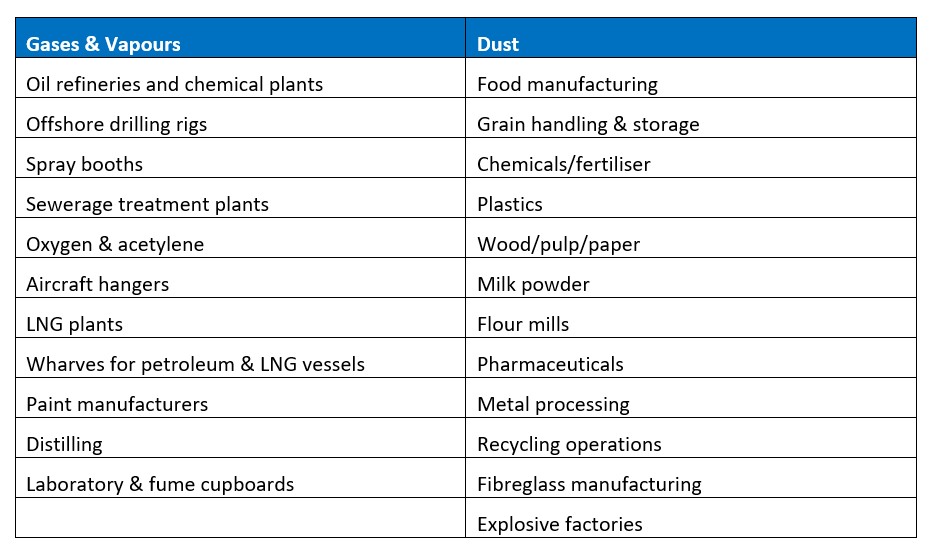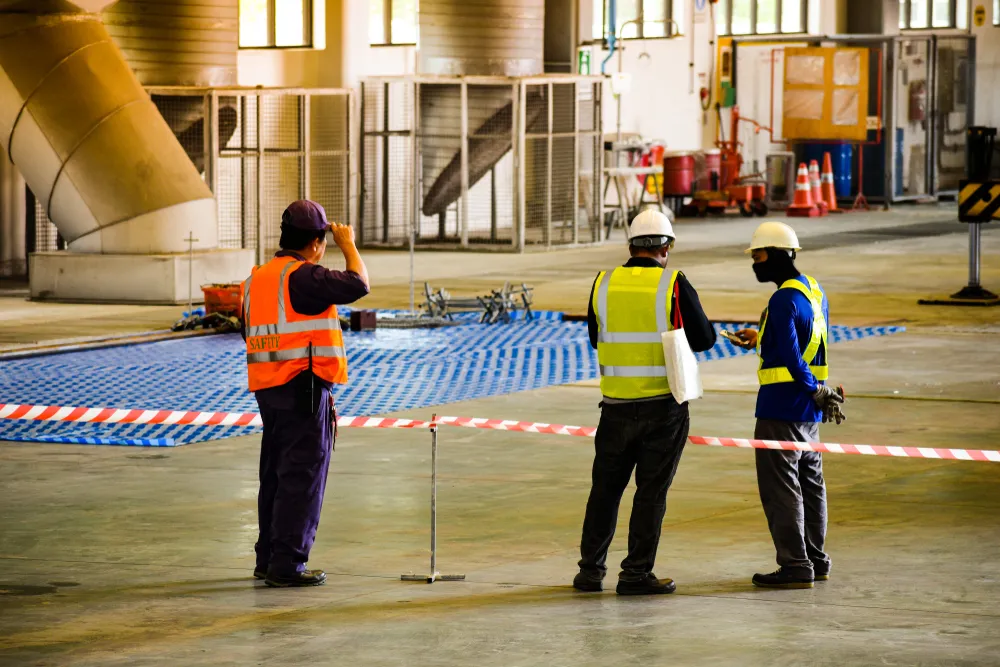Roar Solutions Things To Know Before You Buy
Roar Solutions Things To Know Before You Buy
Blog Article
Fascination About Roar Solutions
Table of ContentsWhat Does Roar Solutions Do?Indicators on Roar Solutions You Need To KnowExcitement About Roar Solutions
In order to safeguard installments from a potential explosion an approach of evaluating and categorizing a potentially dangerous area is called for. The function of this is to guarantee the appropriate option and setup of devices to eventually stop an explosion and to make certain security of life.
(https://www.startus.cc/company/roar-solutions)
No devices needs to be installed where the surface temperature level of the tools is greater than the ignition temperature level of the given risk. Below are some typical dirt harmful and their minimum ignition temperature level. Coal Dust 380C 225C Polythene 420C (thaws) Methyl Cellulose 420C 320C Starch 460C 435C Flour 490C 340C Sugar 490C 460C Grain Dirt 510C 300C Phenolic Material 530C > 450C Aluminium 590C > 450C PVC 700C > 450C Soot 810C 570C The possibility of the hazard existing in a concentration high adequate to create an ignition will certainly differ from place to place.
In order to identify this threat a setup is divided into locations of danger relying on the quantity of time the unsafe is existing. These areas are described as Zones. For gases and vapours and dusts and fibers there are three areas. Area 0 Area 20 An unsafe atmosphere is very most likely to be existing and may exist for lengthy periods of time (> 1000 hours each year) or even continuously Zone 1 Area 21 A dangerous environment is possible but unlikely to be present for extended periods of time (> 10 450 C [842 F] A category of T6 means the minimum ignition temperature level is > 85 C [185 F] Unsafe area electric devices possibly designed for use in higher ambient temperature levels. This would indicated on the ranking plate e.g. EExe II C T3 Ta + 60C( This indicates at 60C ambient T3 will not be gone beyond) T1 T1, T2, T3, T4, T5, T6 T2 T2, T3, T4, T5, T6 T3 T3, T4, T5, T6 T4 T4, T5, T6 T5 T5, T6 T6 T6 A T Course rating of T1 implies the optimum surface temperature produced by the instrument at 40 C is 450 C. Presuming the linked T Course and Temperature rating for the devices are proper for the location, you can always use an instrument with a more strict Department rating than required for the location. There isn't a clear solution to this question unfortunately. It truly does rely on the kind of devices and what fixings need to be accomplished. Devices with particular examination treatments that can't be executed in the field in order to achieve/maintain third event score. Need to return to the factory if it is prior to the devices's service. Field Fixing By Authorised Employee: Complex screening may not be needed however particular treatments might require to be followed in order for the equipment to maintain its 3rd party rating. Authorized personnel have to be utilized to perform the work properly Repair service have to be a like for like replacement. New part need to be thought about as a straight replacement calling for no special testing of the devices after the repair is full. Each piece of devices with a hazardous score should be assessed independently. These are described at a high degree below, however, for more in-depth details, please refer straight to the guidelines.
The Main Principles Of Roar Solutions
The tools register is an extensive data source of devices documents that includes a minimum collection of areas to recognize each item's location, technical specifications, Ex category, age, and environmental information. This information is crucial for tracking and handling the equipment effectively within unsafe locations. In contrast, for periodic or RBI tasting examinations, the grade will certainly be a combination of Thorough and Close inspections. The ratio of In-depth to Shut inspections will certainly be figured out by the Devices Risk, which is assessed based upon ignition threat (the possibility of a resource of ignition versus the probability of a combustible atmosphere )and the dangerous location classification
( Area 0, 1, or 2). This variation will likewise affect the resourcing needs for job prep work. Once Great deals are specified, you can create tasting plans based on the example size of each Lot, which describes the variety of arbitrary equipment products to be evaluated. To establish the needed sample size, two facets need to be reviewed: the dimension of the Great deal and the classification of inspection, which suggests the level of initiative that need to be applied( minimized, normal, or increased )to the evaluation of the Lot. By incorporating the group of inspection with the Lot dimension, you can after that develop the suitable denial criteria for a sample, suggesting the permitted number of malfunctioning items discovered within that example. For even more details on this procedure, please refer to the Power Institute Standards. The IEC 60079 typical advises that the maximum period between evaluations should not exceed 3 years. EEHA examinations will likewise be carried out beyond RBI projects as component of set up maintenance and equipment overhauls or repairs. These examinations can be attributed toward the RBI example sizes within the impacted Great deals. EEHA inspections are conducted to recognize mistakes in electrical devices. A weighted racking up system is important, as a solitary piece of devices might have numerous faults, each with differing levels of ignition danger. If the combined rating of both inspections is less than two times the mistake score, the Whole lot is regarded acceptable. If the Whole lot is still thought about inappropriate, it needs to undertake a full inspection or reason, which might activate more stringent inspection methods. Accepted Great deal: The sources of any kind of mistakes are determined. If a typical failure mode is discovered, extra tools might need maintenance. Mistakes are identified by extent( Security, Stability, Home cleaning ), guaranteeing that urgent problems are examined and dealt with immediately to mitigate any influence on safety or operations. The EEHA database must track and tape-record the lifecycle of faults along with the rehabilitative actions taken. Executing a robust Risk-Based Inspection( RBI )strategy is important for guaranteeing compliance and safety and security in handling Electrical Devices in Hazardous Areas( EEHA) (Roar Solutions). Automated Fault Rating and Lifecycle Management: Easily handle mistakes and track their lifecycle to improve evaluation precision. The intro of this support for risk-based inspection better enhances Inspectivity's setting as a best-in-class option for governing conformity, as well as for any asset-centric assessment usage instance. If you want finding out extra, we invite you to ask for a demo and find how our option can change your EEHA monitoring procedures.
Roar Solutions Can Be Fun For Anyone

In terms of explosive risk, a hazardous area is a setting in which an eruptive atmosphere exists (or might be expected to be present) in amounts that call for special preventative measures for the building and construction, setup and use of tools. eeha. In this article we discover the difficulties encountered in the workplace, the threat control procedures, and the needed proficiencies to work safely
These substances can, in specific conditions, form eruptive ambiences and these can have major and unfortunate repercussions. Most of us are familiar with the fire triangle get rid of any one of the 3 aspects and the fire can not take place, yet what does this mean in the context of hazardous locations?
In most circumstances, we can do little regarding the levels of oxygen in the air, yet we can have significant impact on resources of ignition, for example electrical tools. Dangerous locations are recorded on the dangerous location classification illustration and are identified on-site by the triangular "EX-SPOUSE" sign. Below, among various other crucial info, zones are divided into three kinds depending upon the hazard, the possibility and duration that an explosive ambience will certainly exist; Zone 0 or 20 is deemed the most hazardous and Area 2 or 22 is discover this regarded the least.
Report this page